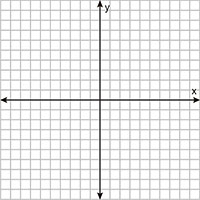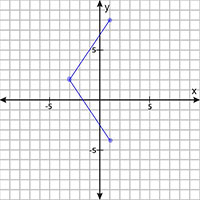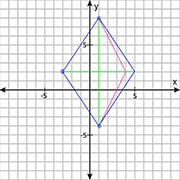Missing Vertices in a Coordinate Plane on the ISEE
All Levels
ISEE Question: Three vertices of a rhombus lie at (1, 8), (-3, 2), and (1, -4). What are the coordinated of the missing fourth vertex?
A) (2, 5)
B) (4, 2)
C) (5, 2)
D) (-2, 5)

Solution: Although the question gives you a coordinate system to work on, it doesn’t label it, so the scale is up to you!
Helpful Tip: If the ISEE doesn’t give you a grid for a coordinate geometry question, find one on another page of the test and use it instead. Your test booklet is yours to mark as you wish!
STEP 1: Let’s create the scale. The largest coordinate number we see in the question 8, and the grid has ten squares in each direction from the origin, so it’s best to use each square as one unit. Nice and simple!
STEP 2: Label just a few numbers on the graph, like the 5 and -5 on each axis, then plot the three vertices and connect them.

STEP 3: Look at the graph and estimate where the missing vertex needs to go. It’s definitely going to be in the first quadrant (the top right, where both coordinates are positive), so we can eliminate answer choice D).
STEP 4: If you plot the points of the other three answer choices and try connecting them, you’ll see that while B) and C) both look promising, answer choice A) definitely doesn’t connect into a perfect diamond. (Another Helpful Tip: The ISEE often tries to trick you into switching the X and Y coordinates; notice that answer choice A) has the same coordinates as answer choice C) but flipped!)

Since a rhombus (or diamond) is perfectly symmetric, the vertices must be an equal distance from the center. Drawing the diagonals helps show that the left vertex is four squares to the left of the center of the figure at point (1, 2), so the missing vertex must be four squares to the right of it. The correct answer is C).




